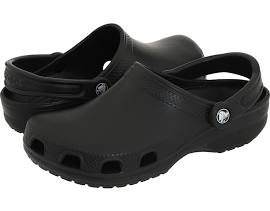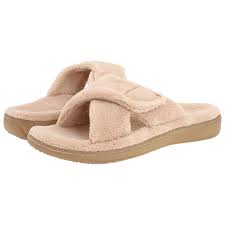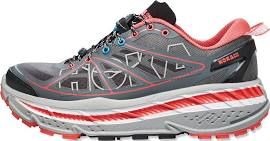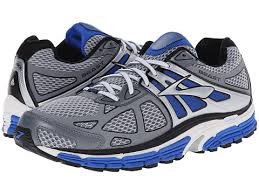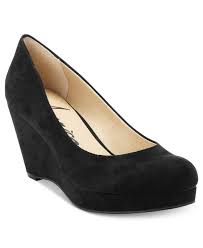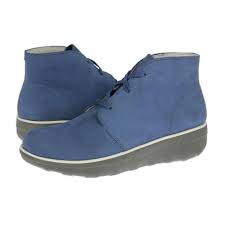Top Shoe Recommendations
for Plantar Fasciitis
Podiatrist Recommended
Plantar Fasciitis is surprisingly common in patients of all ages, foot types, body weights and occupations. The plantar fascia is a strong piece of soft tissue that is made up of three connected bands (medial, central and lateral bands) of soft tissue that runs from the bottom of the heel along the underside of your foot and into each of the toes. Plantar fasciitis occurs when there is inflammation, irritation and mechanical strain of the plantar fascial band as it inserts into the heel bone (calcaneus). The typical presentation of plantar fasciitis is that when you first wake up in the morning and when you step down, the heel hurts so badly that you have to hobble or limp. As you continue to walk, the plantar fascia will get stretched out and 'warms up' and then the pain improves. Usually, every time you sit down for any length of time and have to stand up and walk again -- the process repeats itself.
However, not all heel pain is plantar fasciitis. Many other conditions can mimic plantar fasciitis, including:
*Calcaneal Stress Fracture (stress fracture of the heel bone)
*Partial or complete tear of the Plantar Fascia
*Radiculopathy (pinched nerve in the spine) causing burning pain in the heel
*Foot Fractures / Broken Bones
*Tarsal Tunnel Syndrome
*Achilles Tendonitis
*Nerve Entrapment of the Medial Calcaneal Nerve
*Calcaneal Cyst
*Soft Tissue Mass (Benign or Malignant)
*Rheumatoid Arthritis
*Psoriatic Arthritis
*Injury to the Fat Pad
*Bone Malignancy
*Gout
*Flexor Tendonitis or Tear
*Effects of long-term Compensation (limping) caused by another underlying foot, ankle, knee, hip or lower back issue.
The shoe recommendations listed below are a good starting point for dealing with heel pain. Making basic shoe changes should significantly help with the pain caused by plantar fasciitis. However, if the heel pain is not quickly resolving, I highly recommend that you follow up with your local podiatrist for an office consult and x-rays. There are many excellent conservative, non-surgical treatments for plantar fasciitis, including physical therapy, orthotics, stretching, icing, elevation, topical pain relievers, NSAIDS and rest.
Shoes that help with Plantar Fasciitis:
However, not all heel pain is plantar fasciitis. Many other conditions can mimic plantar fasciitis, including:
*Calcaneal Stress Fracture (stress fracture of the heel bone)
*Partial or complete tear of the Plantar Fascia
*Radiculopathy (pinched nerve in the spine) causing burning pain in the heel
*Foot Fractures / Broken Bones
*Tarsal Tunnel Syndrome
*Achilles Tendonitis
*Nerve Entrapment of the Medial Calcaneal Nerve
*Calcaneal Cyst
*Soft Tissue Mass (Benign or Malignant)
*Rheumatoid Arthritis
*Psoriatic Arthritis
*Injury to the Fat Pad
*Bone Malignancy
*Gout
*Flexor Tendonitis or Tear
*Effects of long-term Compensation (limping) caused by another underlying foot, ankle, knee, hip or lower back issue.
The shoe recommendations listed below are a good starting point for dealing with heel pain. Making basic shoe changes should significantly help with the pain caused by plantar fasciitis. However, if the heel pain is not quickly resolving, I highly recommend that you follow up with your local podiatrist for an office consult and x-rays. There are many excellent conservative, non-surgical treatments for plantar fasciitis, including physical therapy, orthotics, stretching, icing, elevation, topical pain relievers, NSAIDS and rest.
Shoes that help with Plantar Fasciitis:
Rx Crocs Relief
(also: Rx Crocs Ultimate Cloud, Specialist or the fleece-lined Mammoth for colder climates - or colder feet!)
Rx Crocs are my number one choice for bedroom slippers. Barefoot walking is one of the worst things that you can do when you have plantar fasciitis -- or any foot problem! The only time you should be barefoot and standing is in the shower. Even if you get up at night to go to the bathroom, you should step out of bed and directly into your Rx Crocs. Make sure to wear the strap to the back for more biomechanical control, which will help with the plantar fasciitis.
The Rx Crocs puts a firm, stable, shock-absorbing surface between your heel and the floor. If you do nothing else but stop walking barefoot and wear the Rx Crocs as a bedroom slipper -- you should see at least a 30% improvement in foot, knee, hip and lower back pain within three weeks. You will also save money in medical bills because the Rx Crocs will help prevent everything from stepping on foreign bodies, developing warts, and preventing broken toes, tendonitis and heel pain (to name a few). An added benefit is that if you wear Rx Crocs on a regular basis for a bedroom slipper, as you get older, you should have prettier feet than if you were walking barefoot. The Rx Crocs will slow the progression of calluses, bunions and hammertoes, which will give you prettier feet, less pain and will pay off big time as you get older. Remember, you are either beating up your feet or you are beating up your shoes. If you think about what your shoes look like after a couple of years of wear -- that is what is happening to your joints if you are not protecting them! It is your feet versus miles and many years of concrete surfaces. If you are not protecting your feet -- the concrete will win.
If you are ordering online, I have a 20% coupon that will link you to the Crocs website that can be found on the right hand column of this blog. Also, if you do order online, you need to order one-half or one whole size up. If you are a size eight, then order a nine. If you are a size eight-and-a-half, then order a nine. When you try on the Rx Crocs, if your toes hit the front of the Crocs, then they are too small. If the Rx Crocs feel too large, then that is the right size. Remember, the Rx Crocs are to be used as a bedroom slipper so they are for puttering around the house until you are ready for your day and can put on a better, more supportive shoe. Do not try to exercise or do yardwork in your Rx Crocs as those activites require better shoes such as the New Balance 928 or other options listed below.
The Rx Crocs puts a firm, stable, shock-absorbing surface between your heel and the floor. If you do nothing else but stop walking barefoot and wear the Rx Crocs as a bedroom slipper -- you should see at least a 30% improvement in foot, knee, hip and lower back pain within three weeks. You will also save money in medical bills because the Rx Crocs will help prevent everything from stepping on foreign bodies, developing warts, and preventing broken toes, tendonitis and heel pain (to name a few). An added benefit is that if you wear Rx Crocs on a regular basis for a bedroom slipper, as you get older, you should have prettier feet than if you were walking barefoot. The Rx Crocs will slow the progression of calluses, bunions and hammertoes, which will give you prettier feet, less pain and will pay off big time as you get older. Remember, you are either beating up your feet or you are beating up your shoes. If you think about what your shoes look like after a couple of years of wear -- that is what is happening to your joints if you are not protecting them! It is your feet versus miles and many years of concrete surfaces. If you are not protecting your feet -- the concrete will win.
If you are ordering online, I have a 20% coupon that will link you to the Crocs website that can be found on the right hand column of this blog. Also, if you do order online, you need to order one-half or one whole size up. If you are a size eight, then order a nine. If you are a size eight-and-a-half, then order a nine. When you try on the Rx Crocs, if your toes hit the front of the Crocs, then they are too small. If the Rx Crocs feel too large, then that is the right size. Remember, the Rx Crocs are to be used as a bedroom slipper so they are for puttering around the house until you are ready for your day and can put on a better, more supportive shoe. Do not try to exercise or do yardwork in your Rx Crocs as those activites require better shoes such as the New Balance 928 or other options listed below.
Vionix Relax Slippers
(If Rx Crocs don't work for you, this is another good option for a bedroom slipper)
If you don't like the Rx Crocs, the Vionix Relax slipper is an excellent option. The sole is thick, rigid and has excellent arch support. I would like it even better if it had rearfoot control, but, because the sole is so sturdy and it has such good arch support, this is another excellent option for anyone with plantar fasciits. You can purchase the Vionix Relax slippers online at many sites including Footsmart.com.
This bedroom slipper (as well as the Rx Crocs) are approved by the American Podiatric Association for diabetic patients. I would recommend that all diabetic patients go to their podiatrist and eye specialist at least once a year for diabetic foot and eye checks. If you are diabetic, our job as your podiatrist is to keep your feet attached to you! Protective shoegear and proper bedroom slippers are important to helping us achieve that goal.
Hoka One One Stinsen ATR
The Hoka One One Stinsen ATR is an amazing running shoe! I use this shoe for walking and hiking also. Hoka shoes are designed for people who have been told by a doctor that they should never run again because of knee, hip or lower back pain. The Hoka has three times more support and shock absorption then most shoes. I highly recommend that you add arch support (over-the-counter or a custom-molded orthotic) for better arch control, which will help with plantar fasciitis. The Hokas tend to run small, so I recommend that you find a local store to try on the shoe. I had to go one whole size up for a proper fit. I love this shoe and it is perfect for heel pain! Not all Hokas all appropriate for heel pain, but this particular one is excellent.
New Balance 928
(also comes in brown, black leather, and grey)
The NB 928 is an amazing walking shoe! What makes this shoe excellent is that it has 'roll bar' technology in the sole so that there is no motion through the bottom of the foot. The plantar fascia is a long piece of soft tissue that starts in the heel, runs under the bottom of the foot and ends under the far tips of the toes, so if there is motion in the forefoot area of the foot (which would happen with a flexible-soled shoe) then the plantar fascia is pulling on the portion of the heel that hurts. The NB 928 also has an extra-depth toebox which works great for anyone with Bunions, Hammertoes, Tailor's bunions, Morton's Neuromas, Hallux Limitus or Hallux Rigidus. I would highly recommend that you wear this shoe with arch support to help control any over-pronation so that there is less 'pull' on the heel by the plantar fascia. Less strain means there should be less inflammation and irritation to the plantar fascia as it inserts into the calcaneus, which means it will get better faster and you will have less pain.
Brooks Beast
(Running Shoe)
The Brooks Beast is my go-to shoe for getting teenage boys into better shoes. Try getting a teenager to wear the NB 928! The Brooks Beast is a maximum motion-control running shoe and, worn with a custom-molded orthotic or a good over-the-counter arch support, this shoe will help with getting the plantar fasciitis to resolve.
Drew Surge
The Drew Surge is great for men who work all day on their feet -- particularly on concrete surfaces. It's not good enough for the construction site -- for that you might need a Red Wing boot with a full-length metal shank, arch support and a Tully's heel cup on top of the arch support, but the Drew Surge is a great option for men with plantar fasciitis who work long hours on concrete surfaces.
Wolky Jewel Sandals
(also: the Wolky Tulip, Ruby or the Cloggy)
I love this sandal! It has a thick, rigid and non-flexible sole as well as cushioned insole with good arch support. I also love that it has forefoot, midfoot and rearfoot control, which will allow for more biomechanical control of the foot and ankle. Once you are protecting the foot with better shoes, such as the Wolky Jewel, then the plantar fasciitis will have an opportunity to calm down and heal. When you purchase this sandal, make sure you buy the one with the most rigid and non-flexible sole as that will help you heal faster. Quality varies within every shoe line and I find that about 10% of the time, shoes can be made poorly, be defective or be of poor quality. That is not typically the issue with Wolky shoes, but it is always good to double check each shoe before you purchase it.
Birkenstock Rio Sandals
Birkenstock sandals are amazing. I prefer the Rx Crocs as a bedroom slipper for plantar fasciitis because they offer more heel cushioning and shock absorption, but the Birkenstock sandals are another option for people who don't like the Rx Crocs. You can wear the Birk sandals as bedroom slippers and/or as your go-to summer sandal. The rigid sole offers excellent protection and support for your foot joints. It also has very good arch support, which helps with over-pronation and will take much of the strain off of the plantar fascia. Make sure that you get the Birkenstock sandals with the rearfoot strap, so you can maximize biomechanical control of your foot and ankle structures. It will help with your plantar fasciitis pain and you will heal faster.
MBT
(Not recommended for anyone with Achilles Tendonitis)
MBT's are a strong shoe and are not recommended for all foot types. If you have a history of Achilles tendonitis -- you should never be wearing a rocker bottom shoe (which is the type of sole shown above). A rocker bottom sole will 'tip' you backwards onto your heel, which can aggravate any existing or healing Achilles tendonitis issue and it can even lead to a partial tear. I would recommend that you go to the store and try on this shoe. If it doesn't feel comfortable or if you feel unstable in it -- this is not your shoe!
The rocker bottom sole 'off-loads' the forefoot and the rearfoot, which has the effect of lessening strain to those two areas. By lessening stress to the heel, the rocker bottom shoe decreases strain on the plantar fascia, which gives it a chance to calm down and heal.
The MBT literature states that you do not need arch support with this type of shoe. In my opinion, I do think that the MBT shoe works better with arch support -- particularly if you have plantar fasciitis. If your arch support doesn't feel good in the MBT's, then wear the MBT's without arch support. Ultimately, the acid test is how your feet feel while wearing the shoes and arch supports. If a shoe or arch support hurts, then they are not right for you. If every shoe hurts -- then go to your podiatrist for an evaluation and x-rays to make sure there is nothing more serious going on.
MBT sandals
Please see the review above for the MBT as the same recommendations apply.
Sketcher Shape-Ups
(not recommended for anyone with Achilles Tendonitis)
The Sketecher Shape-Ups have gotten a bad-rap in the media. The company got sued because they made false claims. The company claimed that if you wore the Sketcher Shape-Up that they would shape-up your butt. They had no medical research to back up their claims, so they lost millions in the lawsuit. However, the Sketecher Shape-Ups (like the MBT) are not for every foot type or patient, but they can be an excellent choice for some patients who suffer with plantar fasciitis. I would not recommend this shoe to anyone with a history of Achilles tendonitis, instability, geriatric patients or drop-foot. I would recommend that you go to the store and try on this shoe and see if it works for you. I would also recommend that you wear arch support in this shoe for better results. The rocker bottom soles typically work well for anyone who works long hours on on concrete surfaces.
MBT Mary Janes
Please see the comments above for the MBT or Sketcher Shape-Ups as the same information applies.
Dansko Professional Clogs
(works well for some people who works on smooth concrete surfaces such as retail or hospitals)
If you work long hours on concrete floors, the Dankso Professional Clog may be an excellent choice for you. It has a rigid, non-flexible sole which is very protective of the foot joints and allows for less motion and 'pull' of the plantar fascia where it inserts into the heel bone (calcaneus). Danskos are not for everyone. If you have extremely high arches or prominent 'bumps' on your feet (particularly the top of your midfoot or severe bunions) these may not work for you. I recommend that you try them on at the store as you are either going to love them or hate them.
When I switched from all day classes at podiatry school (after 2nd year) and was thrown into the hospitals to stand on my for 10-12 hours per day (3rd and 4th years and residency), I developed a wicked case of plantar fasciitis. The Dankso Professional Clog was a life-saver! They work for my feet perfectly and, to this day, the Dansko Professional Clog is one of my go-to work shoes for all day wear. I do not recommend wearing this shoe if you work on uneven surfaces or you are going to Europe or on vacation to someplace where there is a lot of cobblestone. I also wear a thin heat-molded over-the-counter insert that we make in our ofice in this shoe for added arch control. You may also be able to also use a thin dress custom-molded orthotic for arch control with this shoe.
Z-Coils
(If all else fails - these are excellent for heel pain!)
Okay, if all else fails - where do you turn? The Z-Coil is a strange looking shoe, but it is a great option for anyone suffering with heel pain and/or lower back pain. This shoe will not work for every foot type or for every patient, but I recommend that you go to the store and try it on. You will either love it or hate it. This shoe is not recommended for anyone working on uneven surfaces or who has neuromuscular disorders such as drop foot or weak legs. It is also not for geriatrics.
Powersteps
(If you don't have custom-molded orthotics)
If your insurance doesn't cover custom-molded orthotics, then the Powerstep insert is an excellent over-the-counter option for added arch support for most of the walking shoes listed above (i.e. the NB 928, Drew Surge and Brooks Beast, MBT's and Sketcher Shape-Ups).
Our office carries another excellent over-the-counter insert (Footsteps), which is a cash pay product of $50. If you would like to try on the Footsteps with your shoes, make an appointment at our office with Callie (no charge) and you can try them on to see how they feel.
Custom-molded orthotics are the best as they are prescriptions and custom-molded to your individual feet -- much like the difference between getting prescription glasses as opposed to 'cheaters'. However, if custom-molded orthotics are not covered by your insurance and you are on a budget -- the Footsteps or the Powersteps are good alternatives to custom-molded orthotics.
Tully's Heel Cups
(You can place these on top of your current orthotics or the custom-molded orthotics for more heel cushioning)
This is my favorite heel cup. It takes up a bit more room in the shoe, but it provides excellent heel cushioning and shock absorption. You can purchase these in stores and online.
Golden Rule:
If your foot is not significantly improving quickly with these shoe changes -- follow up with your local podiatrist for x-rays and evaluation to make sure there is not something more serious going on. If it is plantar fasciitis, there are many non-surgical, conservative and gentle treatments that will resolve the heel pain. In my opinion, heel pain can be resolved without surgery or injections 99.9% of the time. Once the heel pain resolves (no matter what treatment type you use) -- if you do not wear protective shoe gear, you have a very high chance of the heel pain re-occuring because, typically, there is an underlying foot type, biomechanical structure or issue that makes you prone to getting heel pain.
I hope that was helpful!
Dr. Cathleen A McCarthy
:)
Check out my latest novel - available in paperback, on Kindle and as an Audiobook on Audible.com and iTunes.
